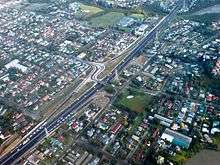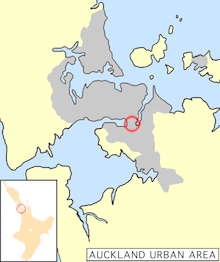Otahuhu
| Ōtāhuhu | |
|---|---|
 Part of eastern Ōtāhuhu from the air | |
 | |
| Basic information | |
| Local authority | Auckland Council |
| Population | 11,991 (2001) |
| Facilities | |
| Train station(s) | Otahuhu Train Station |
| Surrounds | |
| North | Mount Wellington |
| Northeast | (Tamaki River), Pakuranga |
| East | (Tamaki River), East Tamaki |
| Southeast | Ōtara |
| South | Middlemore, Papatoetoe |
| Southwest | Favona, Mangere East |
| West | (Mangere Inlet) |
| Northwest | Westfield |
Ōtāhuhu is a suburb of Auckland 13 kilometres (8.1 mi) to the southeast of the city centre, on a narrow isthmus between an arm of the Manukau Harbour to the west and the Tamaki River estuary to the east. The isthmus is the narrowest connection between the North Auckland Peninsula and the rest of the North Island, being only some 1200 metres wide at its narrowest point, between the Ōtāhuhu Creek and the Mangere Inlet. As the southernmost suburb of the former Auckland City it is considered part of South Auckland.
The suburb's name is taken from the Māori name of a volcanic cone also known as Mount Richmond. The name refers to 'the place of Tāhuhu', a Maori ancestor Tāhuhu-nui-a-Rangi who settled the area. In colloquial speech locals typically shorten the name to "Otahu".
History
The suburb was established in 1847 as a fencible settlement, where soldiers were given land with the implied understanding that in wartime, they would be raised as units to defend it (however, the eventual fighting a decade later used professional soldiers instead). Most early features from this time have disappeared however, such as a stone bridge built by the fencibles that had to make way to a widening of Great South Road.[1]
Ōtāhuhu was home to the country's first supermarket, and Ōtāhuhu College, to which several famous personalities went, including heavyweight boxing champion David Tua, former prime minister David Lange, and ex-Manukau City Mayor, Sir Barry Curtis.
Transport
Ōtāhuhu, in its position on a narrow section of the Auckland Isthmus, is an important part of Auckland's southern transportation approaches for both road and rail, containing a major bus interchange and Otahuhu Train Station. The bus interchange, which was badly neglected, has received increased attention from early 2011 on, with Maori Wardens present, and increased vandalism/graffiti prevention measures.[2]
The importance for transportation extended to pre-European times. The aptly named Portage Road runs across the isthmus in Ōtāhuhu and was used by Māori to move their waka (canoes) between the Manukau and Waitemata harbours for raids and trading. In fact, the area, also known as Te Tō Waka, was considered the most important portage of all of New Zealand.[3][4]
Present Day
Ōtāhuhu nowadays is synonymous with industry and along with its neighbouring suburbs Favona, Mangere East, Mt Wellington, Penrose and Westfield forms a industrial conglomerate zone that's spans pretty much all of the Mangere Inlet. The community and town centre flourishes as the crossroad to Central and South Auckland and is home to sizeable Pacific Island populace.
Sport and recreation
Ōtāhuhu is home to the Ōtāhuhu Rugby Football Club and the Ōtāhuhu Leopards rugby league club.
References
- ↑ "Auckland: Soldiers of fortune". The New Zealand Herald. 26 August 2010. Retrieved 5 February 2011.
- ↑ "Press release: Ōtāhuhu Bus Station Clean Up Begins". Auckland Transport. 14 January 2011. Retrieved 17 January 2011.
- ↑ "Maori Tribal History - Hongi's Expeditions". Te Ara: The Encyclopedia of New Zealand. Retrieved 17 January 2011.
- ↑ "Other northern canoes - Te Tō Waka – the canoe portage". Te Ara: The Encyclopedia of New Zealand. Retrieved 17 January 2011.
External links
- Photographs of Otahuhu held in Auckland Libraries' heritage collections.
Coordinates: 36°56′43″S 174°50′42″E / 36.94528°S 174.84500°E